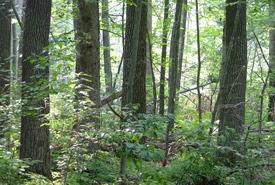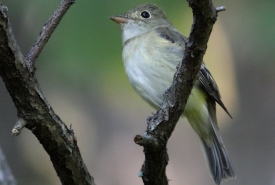A trip back in time: Exploring the history of Backus Woods

Backus Woods, Ontario (Photo by Mary Gartshore)
A hike into Backus Woods is like taking a step back nearly 200 years in time. Located in southwestern Ontario, this natural wonder is one of the most ecologically diverse areas in Canada. It also contains many cultural remnants. A visit to Backus Woods is sure to trigger curiosity and inspiration for any nature lover. Backus Woods is backed by a rich history of land stewardship, and its hiking trails tell many enlightening stories. By joining forces with the Nature Conservancy of Canada (NCC) as a visitor, volunteer or donor, you can help ensure this special place remains to inspire and teach future generations.
In 1796 John H. Backhouse arrived in the Long Point District from Yorkshire, England. He started a sawmill on 600 acres (242 hectares) of land he received as a land grant – what would later be known as Backus Woods. He later added a grist mill. When you travel to the region today, you can find the grist mill still standing; it is now the oldest one in Ontario. Having survived American gunfire during the War of 1812, the mill is a rare site to visit. It is located in the nearby Backus Heritage Conservation Area (next door to NCC’s lands), operated by the Long Point Region Conservation Authority (LPRCA).

Acadian flycatcher (Photo by Bill Hubick)
The primary natural resource value of the Backhouse lands was lumber, much of which was exported to build the Welland Canal and various railways. Lumber was in high demand, but the Backhouse family recognized that the forest could only sustain so much yield before it became threatened. Thanks to these early stewardship mindsets, Backus Woods remains intact today and supports many species at risk, including wood thrush, Acadian flycatcher and Blanding’s turtle.
You’ll probably notice a change from 200 years ago: The woods are now called “Backus Woods” and not “Backhouse Woods.” As the years went on, the Backhouse milling operations were carried out by successive generations of the family. Eventually, John H.’s grandson, John Cornelius, changed the family surname to Backus. This was because he felt that the name “Backhouse” had negative connotations for their product (flour) at the grist mill. John C. and his wife, Florence Erie, fostered a strong sense of environmental conservation in their kin. In 1955, the couple decided to take action to protect the natural values of the property far into the future. In a letter to the Big Creek Conservation Authority (now LPRCA), John C. Backus conveyed his family’s thoughts:
“It is the wish of the Backus family today to have the estate taken over by the Big Creek CA and preserved in its entirety for the benefit of future generations. We would like the privilege extended to our children and grandchildren to roam freely over their old homestead and through the woods which they helped conserve.”
Fast forward to today, and thanks to many dedicated naturalists, partners and collaborators, the dreams of the Backus family have been realized.
Exploring Backus Woods can lead to interesting discoveries…look closely! The Backus family only harvested the largest trees when they became diseased or damaged. For example, a tulip tree measuring 1.35 metres in diameter was discovered after a lightning strike, and the growth rings showed that it was over 500 years old. Many of the current trails on the high, sandy ridges at Backus Woods were originally haul roads, which were used to carry logs by horse. These historical uses come to life when exploring Backus Woods and allow visitors to make the connection between land use and environmental conservation.
Through time and changes in ownership, one thing has remained constant in Backus Woods: the idea of hands-on, practical approaches to conservation. Thanks to the Backus family, the LPRCA and local taxpayers, the Ontario Ministry of Natural Resources, Ontario Heritage Trust, Government of Canada through the Natural Areas Conservation Program and The W. Garfield Weston Foundation, Backus Woods is still an outstanding example of the largest remaining intact closed-canopy Carolinian forest in Canada.
Backus Woods has been awaiting your visit for over two centuries. What an exciting opportunity!
Ontario’s Conservation Technicians are funded in part by the Government of Canada’s Summer Work Experience program, the Government of Ontario’s Career Ready Fund, the Ontario Trillium Foundation, Bruce Power and Mountain Equipment Co-op.


